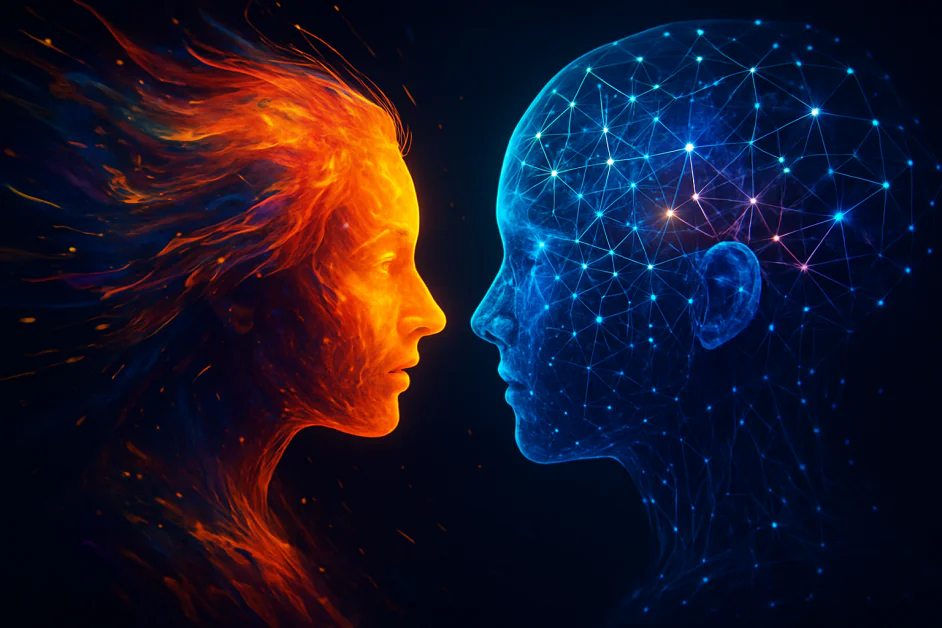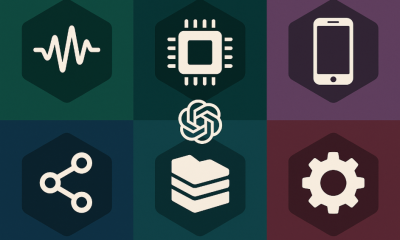Artificial Intelligence
AI and Human Creativity: Can Chaos Theory Make Machines Think Differently?

Artificial Intelligence (AI) is transforming many areas of life. It can write text, generate images, compose music, and solve complex problems. But an important question remains: can AI truly be creative, or is it only repeating and rearranging what it has already learned from past data?
To answer this, we need to understand how human creativity works. It is more than just producing new content. It involves emotion, originality, and the ability to connect distant or unrelated ideas. Creative acts often come from personal experience and unconscious thought. For example, when jazz musicians improvise, their music does not follow strict rules. It feels alive and deeply expressive. This kind of creativity comes from flexible and dynamic mental processes. In neuroscience, creative thinking has been linked to shifting brain activity across different regions, allowing both structure and spontaneity.
In contrast, AI systems work through structure and predictability. They are trained on large datasets to identify patterns and generate responses based on that learning. Tools like DALL·E 3 can produce visually impressive artwork. Yet, many of these images feel familiar or repetitive. On platforms like X, users often describe AI-generated stories as predictable or emotionally flat. This is because AI cannot draw from lived experience or personal emotion. It can simulate creativity, but it lacks the context that gives human expression its depth.
This difference shows a clear gap. Human creativity works through ambiguity, emotion, and surprise. AI, in contrast, depends on order, logic, and fixed rules. To help machines go beyond copying patterns, a different kind of method may be needed. One possible approach is a chaos algorithm inspired by chaos theory. Such an algorithm could introduce elements of randomness, disruption, and unpredictability into AI systems. This might help AI produce results that seem more original and less limited by past data.
AI and the Nature of Structured Thinking
AI systems work by learning from structured data, such as text, numbers, or images. These systems do not think or feel. They follow patterns and use probability to decide what comes next. This helps them respond to tasks like translation, image generation, or summarization. But the process is based on order and control, not free thinking.
Many modern AI systems are based on neural networks to process data. These networks are made up of layers, where each layer contains small units called nodes. Information passes through these layers in a fixed order. Each node processes part of the input and sends the result to the next layer. During training, the model adjusts the strength of connections between these nodes. This helps reduce errors and improve accuracy. After training, the model follows the same path each time it is used.
This design helps keep the AI system stable and easy to control. Developers can track how the model works and fix errors when needed. But this same structure also creates limits. The model often sticks to familiar patterns from its training data. It rarely tries something new or surprising.
Because of this fixed structure, AI behavior becomes easy to predict. The system follows known paths and avoids doing anything unexpected. In many cases, randomness is left out altogether. Even when some randomness is added, it is usually limited or guided. This makes the model stay within safe boundaries. It repeats patterns from the training data instead of exploring new ones. As a result, AI often performs well on defined tasks. But it may struggle when freedom, surprise, or rule-breaking is needed, traits usually linked with creativity.
Why the Human Mind Thinks Differently
Human creativity often follows a non-linear path. Many important ideas and discoveries appear unexpectedly or result from combining unrelated concepts. This element of unpredictability plays a key role in how people think and generate new ideas.
Disorder and flexibility are natural features of human thought. People forget details, make errors, or become distracted. These moments can lead to original insights. Creative professionals, such as writers and scientists, often report that new ideas come during periods of rest or reflection, not through planned steps.
The structure of the human brain supports this flexible thinking. With billions of neurons forming complex and dynamic connections, thoughts can shift freely between different ideas. This process does not follow a fixed sequence. It allows for the formation of new connections that machines find difficult to replicate.
When solving problems, humans often explore unrelated or unusual directions. Stepping away from the task or considering alternative perspectives can lead to unexpected solutions. Unlike machines, which follow clearly defined rules, human creativity benefits from disorder, variation, and the freedom to break patterns.
The Case for the Chaos Algorithm
A chaos algorithm introduces a controlled form of randomness into artificial intelligence systems. This randomness is not unstructured noise. Instead, it helps the model break out of fixed patterns and explore new directions. This idea supports creativity in AI by allowing it to take uncertain paths, test unusual combinations, and tolerate errors that may lead to valuable outcomes.
How Chaos Algorithms Work in AI
Most AI systems today, including models like GPT-4, Claude 3, and DALL·E 3, are trained to reduce error by following statistical patterns in large datasets. As a result, they tend to produce outputs that reflect the data they were trained on. This makes it difficult for them to generate truly novel ideas.
Chaos algorithms help increase flexibility in AI models by introducing controlled disorder into the learning and generation process. Unlike traditional methods that focus on accuracy and pattern repetition, these algorithms allow the model to ignore certain optimization rules temporarily. This enables the system to move beyond familiar solutions and explore less obvious possibilities.
A common approach is to introduce small random changes during internal processing. These changes help the model avoid repeating the same paths and encourage it to consider alternative directions. Some implementations also include components from evolutionary algorithms, which use ideas such as mutation and recombination. These help generate a broader range of possible outputs.
In addition, feedback systems can be used to reward results that are uncommon or unexpected. Instead of only aiming for accuracy, the model is encouraged to produce outputs that differ from those it has previously encountered.
For example, consider a language model trained to write short stories. If the system always generates predictable endings based on familiar patterns, its outputs may lack originality. However, by introducing a reward mechanism that favors less common narrative paths, such as an ending that resolves the story in an unusual yet coherent way, the model learns to explore a broader range of creative possibilities. This approach improves the model's ability to generate novel content while still maintaining logical structure and internal consistency.
Real-World Applications of Creative Chaos in AI
Below are some real-world applications of chaos in AI.
Music Generation
AI music tools such as AIVA and MusicLM now produce melodies that include controlled randomness. These systems add noise during training or vary internal data paths. This helps them create music that feels less repetitive. Some outputs show patterns similar to jazz improvisation, offering more creative variation than earlier models.
Image Creation
Image generators like DALL·E 3 and Midjourney apply small random changes during generation. This avoids copying exact training data. The result is visuals that mix unusual elements while staying within learned styles. These models are popular for producing artistic and original-looking images4.
Scientific Discovery
A notable example of this approach is AlphaFold, developed by DeepMind, which addressed the long-standing scientific challenge of predicting protein structures. Rather than relying strictly on fixed rules, AlphaFold combined structured modeling techniques with flexible, data-driven estimations. By incorporating minor variations and allowing a degree of uncertainty in its intermediate steps, the system was able to explore multiple possible configurations. This controlled variation enabled AlphaFold to identify highly accurate protein structures, including those that traditional rule-based or deterministic methods had previously failed to resolve.
Techniques for Enhancing Creative Variability in AI Systems
Researchers use several strategies to make AI systems more flexible and capable of generating novel outputs:
Introducing controlled noise into the system’s internal processes
Small amounts of randomness can be added at specific stages to encourage variation in outputs. This helps the system avoid repeating exact patterns and supports exploration of alternative possibilities.
Designing architectures that support dynamic behavior
Some models, such as recurrent systems or adaptive rule-based frameworks, naturally produce more varied and sensitive outputs. These dynamic structures respond to small input changes in complex ways.
Applying evolutionary or search-based optimization methods
Techniques inspired by natural selection, such as mutation and recombination, allow the system to explore many model configurations. The most effective or creative ones are selected for further use.
Using diverse and unstructured training data
Exposure to a wide range of examples, especially those that are inconsistent or noisy, improves the system’s ability to generalize. This reduces overfitting and encourages unexpected combinations or interpretations.
These techniques help AI systems go beyond predictable behavior. They make the models not only accurate but also more capable of producing varied, engaging, and sometimes surprising results.
Risks of Introducing Chaos in AI Systems
Using chaos to enhance creativity in AI systems offers potential benefits but also introduces several critical risks that must be carefully addressed.
Excessive randomness can reduce the system’s reliability. In domains such as healthcare or law, unpredictable outputs may lead to serious consequences. For example, a medical diagnostic model that prioritizes unusual or less likely options might overlook established symptoms or suggest unsafe treatments. In such settings, stability and accuracy must remain the primary focus.
Security is another concern. When AI systems explore unfamiliar or unfiltered possibilities, they may generate outputs that are inappropriate, unsafe, or offensive. To prevent such outcomes, developers typically implement filtering mechanisms or content moderation layers. However, these protective measures can limit the AI’s creative scope and sometimes exclude novel but valid contributions.
The risk of reinforcing bias also increases in chaotic or exploratory systems. During unsupervised searches through data, the AI may highlight subtle but harmful stereotypes that were unintentionally present in the training set. If these outputs are not carefully monitored and controlled, they can strengthen existing inequalities rather than challenge them.
To reduce these risks, systems that incorporate chaotic behavior should operate within well-defined boundaries. Algorithms must be evaluated in secure and controlled environments before they are applied in real-world contexts. Ongoing human oversight is essential to interpret and assess outputs, particularly when the system is encouraged to explore uncommon paths.
Ethical guidelines should be embedded into the system from the beginning. AI development in this area must seek a balance between unpredictability and responsibility. Transparency about how variability is introduced and how it is regulated will be necessary for building user trust and ensuring broader acceptance.
The Bottom Line
Introducing controlled randomness in AI allows models to generate more original and diverse outputs. However, this creative flexibility must be carefully managed. Unchecked variability can lead to unreliable results, especially in critical areas such as healthcare or law. It may also expose or reinforce hidden biases present in training data.
To reduce these risks, systems must operate within clear rules and be tested in safe environments. Human oversight remains essential to monitor outputs and ensure responsible behavior. Ethical considerations should be integrated from the start to maintain fairness and transparency. A balanced approach can support innovation while ensuring that AI systems remain safe, reliable, and aligned with human values.












